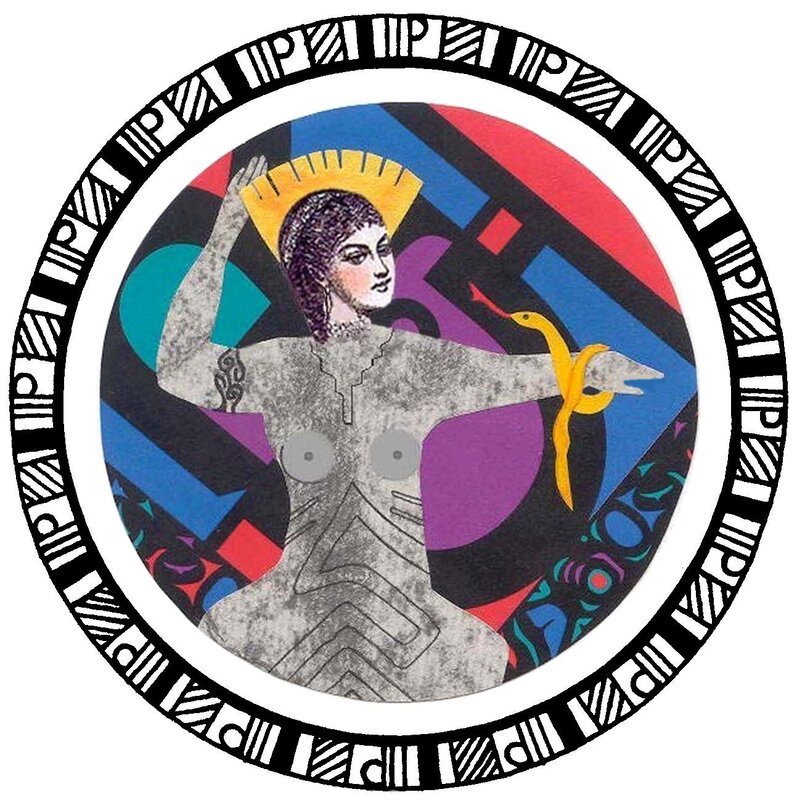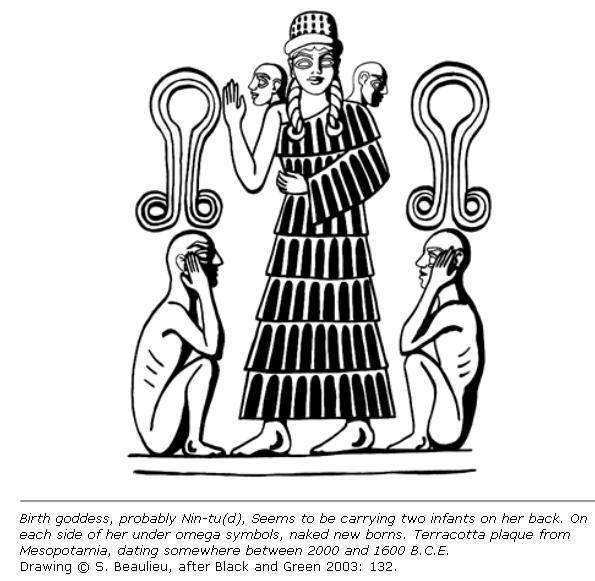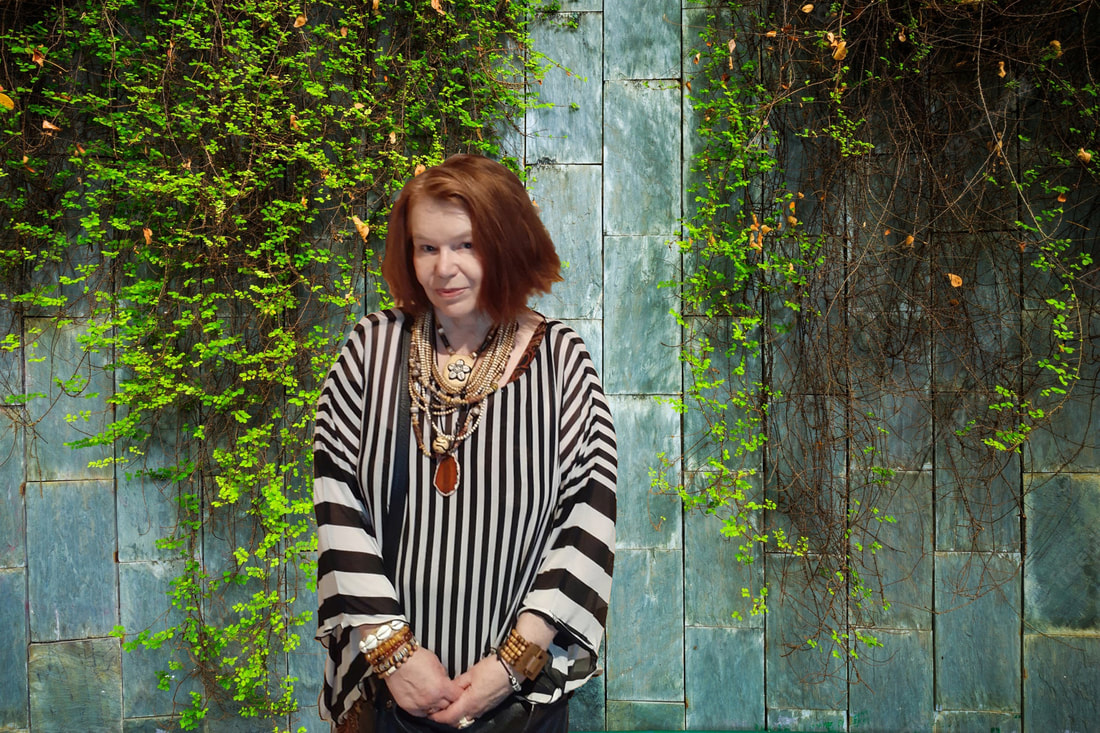PEGI EYERS
"Ninhursaga"
mixed media by Pegi Eyers
available as a notecard >here<
Ninhursaga ~ Birth Goddess ~ Ancient Womb Symbols
A fascinating study of the reverence held for Birth Goddesses in ancient times, the following excerpt is from Johanna Stuckey's article Of Omegas and Rhombs: Goddess Symbols in Ancient Mesopotamia and the Levant. Accessible from Wayback Machine, as the original publisher Matrifocus Journal is now off-line.
Ancient Mesopotamia boasted many Goddesses whose main, but not only function was birthing. They were regularly identified with each other. Dingir-Makh "Exalted Deity" was the Sumerian birth goddess par excellence. Other Sumerian Birth Goddesses included Ninhursaga "Lady of the Mountainous Areas", Nin-makh "Exalted Lady", Nin-tu" "Lady of Birth", Nin-mena "Lady of the Crown", and Nin-sikila "Pure Lady". Many of these Goddesses have multiple names or variants.
The best known of these birth goddesses was Ninhursaga , a great earth deity. Among her titles were "Mother of the Gods" and "Mother of All Children." In the pantheon, she ranked as equal to the sky god An, the god of executive power En-lil, and the god of water/wisdom En-ki. The Sumerian myth "En-ki and Ninhursaga" made it clear that the Goddess had power of life and death even over great deities. The wisdom god En-ki impregnated his and Ninhursaga's daughter Nin-mu, then their granddaughter, and finally Uttu, their great-granddaughter. When Uttu gave birth to eight plants, En-ki ate them all. At this point, Ninhursaga demonstrated not only her anger but her power. She cursed En-ki with death, and soon eight of his body parts began to die. Eventually, when the goddess's anger cooled, she "seated En-ki by her vulva" and gave birth to eight deities, each assigned to heal a particular part of the God. A great deal of Ninhursaga's power was obviously situated in her vulva and womb.
Appropriately, Ninhursaga and the other birth Goddesses were represented by what has been interpreted as a womb symbol. It took the approximate shape of the Greek capital letter omega () and occurred often on seals dating from around 2000 BCE. to the seventh century BCE. The earliest known example dates to the Early Dynastic period (2900-2350 BCE.). Scholars have explained the symbol variously as weighing scales, a wig, swaddling bands, or — to me the most compelling interpretation — a stylized womb. This last interpretation is supported by a clay plaque showing a Goddess with an omega on either side of her and, under the symbols, "human forms resembling newborn babies", possibly stillborn infants. The symbol might also have been connected with the Great Goddess Inanna/Ishtar.
Johanna Stuckey is a scholar of the Divine Feminine, and the author of the classic Women's Spirituality: Contemporary Feminist Approaches to Judaism, Christianity, Islam and Goddess Worship. >link<
A fascinating study of the reverence held for Birth Goddesses in ancient times, the following excerpt is from Johanna Stuckey's article Of Omegas and Rhombs: Goddess Symbols in Ancient Mesopotamia and the Levant. Accessible from Wayback Machine, as the original publisher Matrifocus Journal is now off-line.
Ancient Mesopotamia boasted many Goddesses whose main, but not only function was birthing. They were regularly identified with each other. Dingir-Makh "Exalted Deity" was the Sumerian birth goddess par excellence. Other Sumerian Birth Goddesses included Ninhursaga "Lady of the Mountainous Areas", Nin-makh "Exalted Lady", Nin-tu" "Lady of Birth", Nin-mena "Lady of the Crown", and Nin-sikila "Pure Lady". Many of these Goddesses have multiple names or variants.
The best known of these birth goddesses was Ninhursaga , a great earth deity. Among her titles were "Mother of the Gods" and "Mother of All Children." In the pantheon, she ranked as equal to the sky god An, the god of executive power En-lil, and the god of water/wisdom En-ki. The Sumerian myth "En-ki and Ninhursaga" made it clear that the Goddess had power of life and death even over great deities. The wisdom god En-ki impregnated his and Ninhursaga's daughter Nin-mu, then their granddaughter, and finally Uttu, their great-granddaughter. When Uttu gave birth to eight plants, En-ki ate them all. At this point, Ninhursaga demonstrated not only her anger but her power. She cursed En-ki with death, and soon eight of his body parts began to die. Eventually, when the goddess's anger cooled, she "seated En-ki by her vulva" and gave birth to eight deities, each assigned to heal a particular part of the God. A great deal of Ninhursaga's power was obviously situated in her vulva and womb.
Appropriately, Ninhursaga and the other birth Goddesses were represented by what has been interpreted as a womb symbol. It took the approximate shape of the Greek capital letter omega () and occurred often on seals dating from around 2000 BCE. to the seventh century BCE. The earliest known example dates to the Early Dynastic period (2900-2350 BCE.). Scholars have explained the symbol variously as weighing scales, a wig, swaddling bands, or — to me the most compelling interpretation — a stylized womb. This last interpretation is supported by a clay plaque showing a Goddess with an omega on either side of her and, under the symbols, "human forms resembling newborn babies", possibly stillborn infants. The symbol might also have been connected with the Great Goddess Inanna/Ishtar.
Johanna Stuckey is a scholar of the Divine Feminine, and the author of the classic Women's Spirituality: Contemporary Feminist Approaches to Judaism, Christianity, Islam and Goddess Worship. >link<



